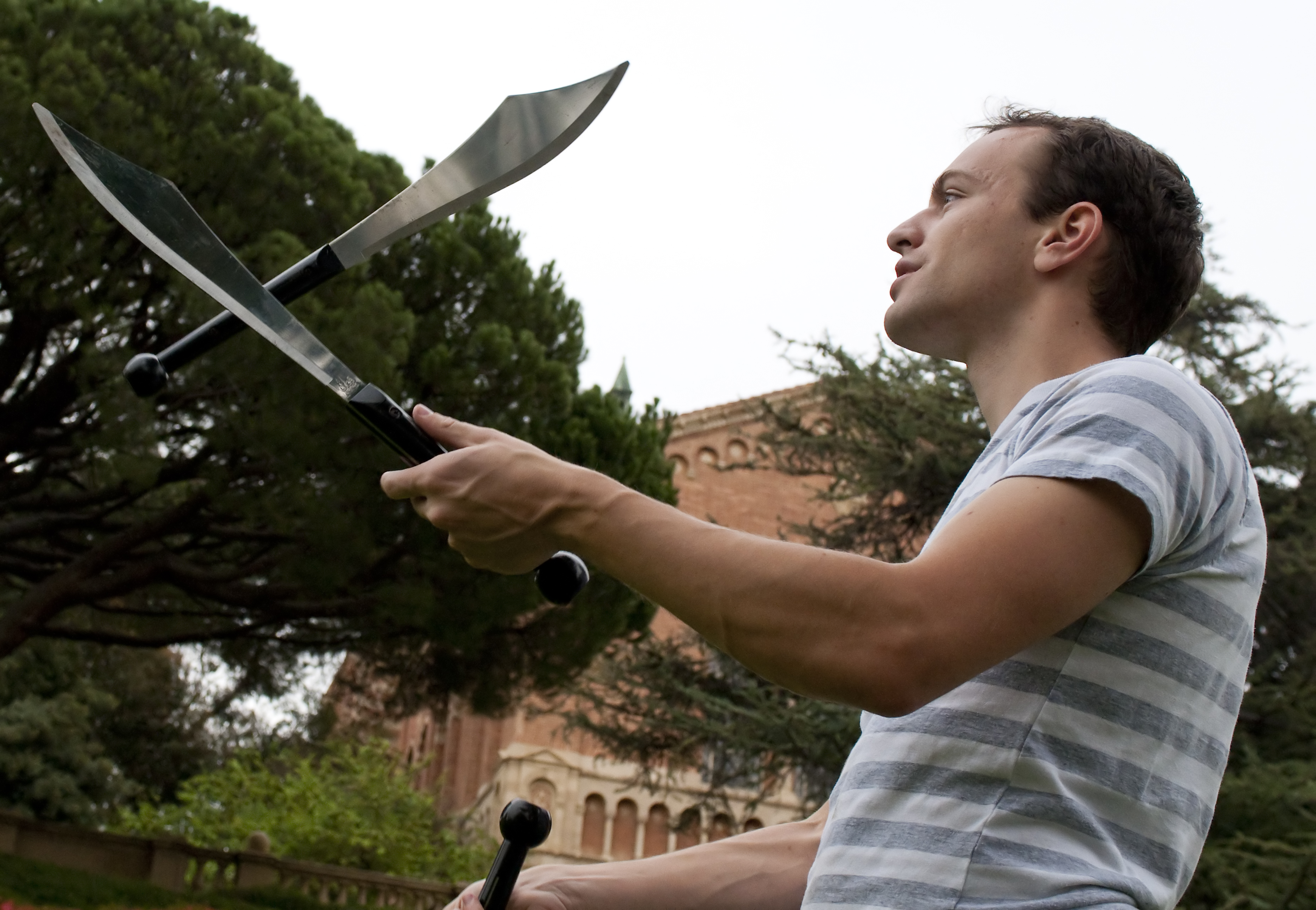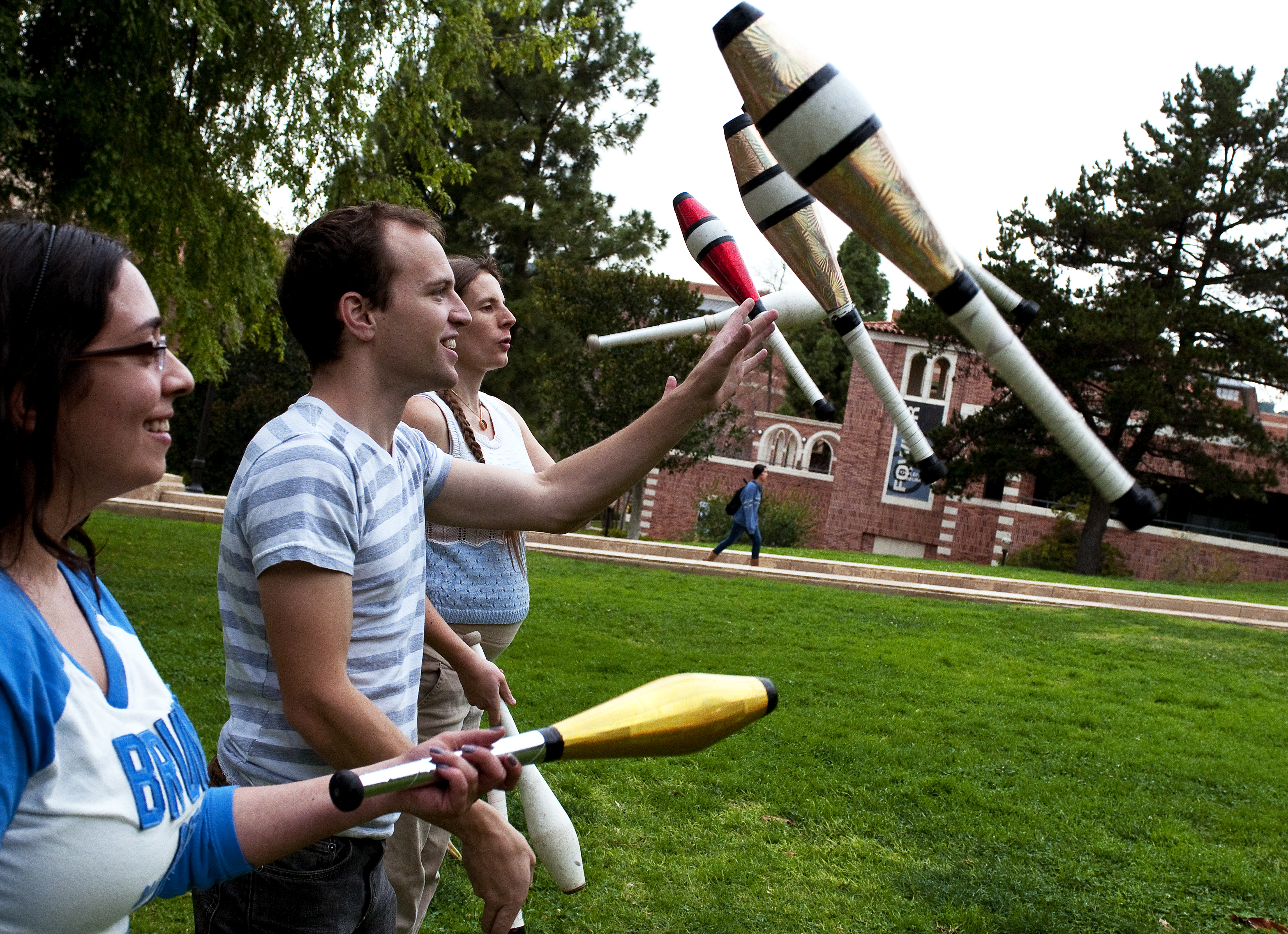
President of the Juggling Club and second-year graduate student in linguistics Michael Lefkowitz performs a routine involving knives. While juggling is primarily performed independently, members of the UCLA Juggling Club sometimes get together and choreograph group routines.
The groups of jugglers on Janss Steps are usually little more than distraction for most students sitting on the grass; few ever actually consider walking up and joining them.
Not so for third-year physiological science student Gloria Young and recent graduate Dan Huynh. They didn’t pass by like most of the hordes of Bruins. They simply walked up and asked to join.
First-year aerospace engineering student Lewis Deyerle immediately handed them each a set of balls and began teaching them the basics.
“Everyone’s so nice,” Young said. “They’re so welcoming and so willing to teach you tricks.”
The Juggling Club started a year ago when second-year graduate student in linguistics Michael Lefkowitz came to UCLA with hopes of finding fellow jugglers. Once he found out the club didn’t exist, he decided to start one.
Huynh and Young had little experience prior to walking up to the club, but they immediately felt welcomed as if they had been long-time friends because of the lessons they received and the personal attention their teachers paid them.
Experienced jugglers such as second-year graduate student in law Farrah Siegel also felt right at home with the club.
“I stumbled across a group of people juggling here last spring, and I was just so happy to find other jugglers,” Siegel said.
Siegel called jugglers “the nicest people you’ll ever meet.” As such a small community, they are always delighted to find a fellow juggler to share tips and tricks with.
The group takes on members of all levels, and as their abilities grow, they get to teach newer members different methods of juggling. It is a skill that simply takes focused practice.
Once one steps across the threshold of throwing three balls in the air and catching them, there is a world of exciting and intricate tricks available to them.
Both Lefkowitz and Siegel started as children, while Deyerle started in high school. But they all started as casual learners looking to pass the time; now for all three of them it has grown into something more.
“I’ve taught quite a few people how to juggle, which I never really thought I would have. (Being at this level) is great,” Deyerle said.
Juggling takes immense focus, and for UCLA students with intense course loads, it can provide an escape in which they perfect a skill other than chemistry or essay writing.
“It’s great to come out here and not think about anything else ““ just to focus on throwing things,” Deyerle said.
While the weather is usually great, the rain can be a threat around this time of year. Last Tuesday, rain and wind kept many students away from class, but a group of jugglers was still out on the grass, juggling in 55-degree weather without a thought to the cold.
The club has 58 members in its Facebook group, but the number of students who show up every week varies, from the eight or so who showed up in the cold to dozens on a beautiful day. Official hours are from noon to 2 p.m. on Tuesdays and 1 to 3 p.m. on Thursdays, but those times are more of a suggestion than a constraint. The club has become a forum for jugglers to find others who also share a love for the activity, so if they can’t make the official hours, jugglers will pair up and find other times to hang out on the grass and throw together.
For this reason, it is not uncommon to see jugglers along the grass at any and all hours of the afternoon, sending brightly colored objects spinning through the air.
“I mean, we’re technically a club sport,” Lefkowitz said. “But that’s mostly bureaucratic. Most people in the club don’t even know that.”
Juggling is a unique sport in that once one drops the clubs or overthrows them, it is easy to just pick up and start again, as opposed to other competitive sports that are highlighted by a need to succeed each and every time.
The variety of juggling tricks and apparatuses goes beyond one person standing alone, throwing three multicolored balls up in the air.
On Tuesday, five of them formed a triangle and each took up two clubs. They tossed them between one another, each spinning one up in the air before passing it to the next juggler. Such intricate tricks are just another day in the life of a member of the Juggling Club.
Although juggling is a primarily individual activity, the members of the club say the benefits of doing it in a large group are among the best parts of being in the club.
They get to learn new methods, such as adding more objects to their throwing, juggling new items or expanding into larger groups. They are encouraged to try new tricks they never would have if they were to practice on their own.
“I’ve improved more in the last quarter of being at UCLA in the Juggling Club than I ever would have on my own,” Deyerle said.
By the time Huynh and Young were finished with their first ever experience with the club, they were almost perfectly juggling three balls. Young went on to learn a trick that involved juggling two balls with only one hand.
“Everyone loves playing catch,” Lefkowitz said. “This is just catch with three people using 12 objects.”
